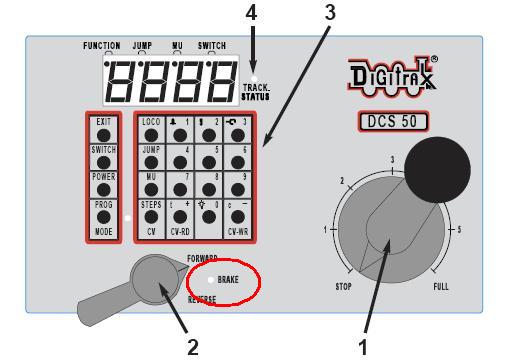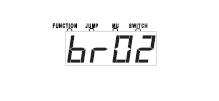To use the pre-set braking rate to stop and start a locomotive:

Move the Direction Control Lever [ 2 ] to the BRAKE position, the Brake Indicator Dot will begin blinking and the loco will slow down to a stop at the brake rate you have set up in the Zephyr DCS50. As the loco slows to a stop, the Brake Indicator Dot will change from blinking to steady on to let you know that the brake is on.
Move the Direction Control Lever to the FORWARD or REVERSE position and the loco will accelerate at the programmed brake rate to the speed on the throttle knob. As the loco accelerates, the Brake Indicator Dot will flash during acceleration and go off when the loco has reached the speed set on the Throttle Knob.
The DCS50 is shipped with the brake rate set at 02. This gives a small amount of deceleration when the brake is applied and a small amount of acceleration when the brake is released.
To change the brake rate:
1. Press the PROG key. The display shows the last programming mode used.
2. Press the MU key. The display shows id00.
3. Press the MU key again. The display shows SPXX where XX is the current speed limit set for this DCS50.
4. Press the MU key again. The display shows brXX where XX is the current brake rate set for this DCS50.
Use the keypad to enter the new brake rate for the DCS50. Setting brake rate at 00 turns the brake feature off. A setting of 01 gives a fast braking (deceleration rate) and startup (acceleration rate) effect and a setting of 15 gives the slow braking (deceleration rate) and startup (acceleration rate) effect when the brake is used.
Press the EXIT key to set the new braking rate and return to normal operation.
NOTE: Changing the brake rate only affects the locomotive controlled by the DCS50 throttle. It does not affect the the decoder programming.
Braking can also be handled on a loco by loco basis if you set up each decoder with acceleration and deceleration rates that simulate the scale effects of braking the train. Then when you command an instant reverse, the system will simulate braking by slowing down the locomotive at the programmed deceleration rate, come to a stop and then accelerate at the programmed acceleration rate in the opposite direction.
